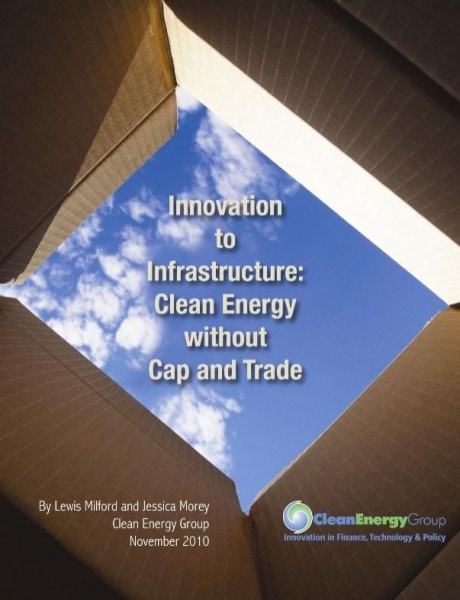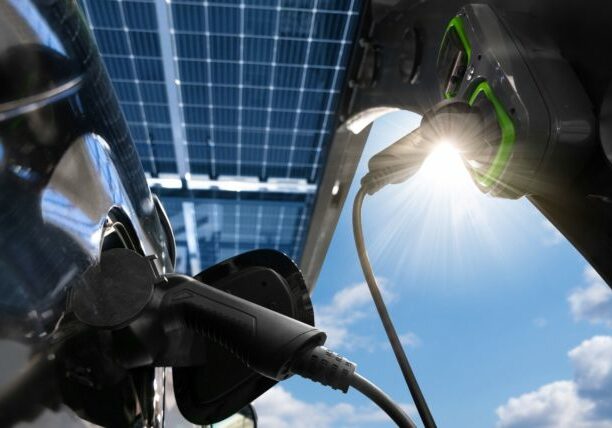November 12, 2010
Innovation to Infrastructure: Clean Energy Without Cap and Trade
By Lewis Milford, Jessica Morey

Clean energy pragmatism demands a new set of policies without cap and trade, without major new federal legislation, and without significantly more federal money. These are likely to be the limiting conditions in future energy policy debates.
If so, the real challenge is whether it is possible to make forward progress — to create “chunks” of energy policy, as President Obama has proposed — in this new environment. Can different clean energy policies answer President Obama’s demand the day after the mid-term election that, without cap and trade, he wants “other means to address this problem …ways we can make progress in the short term and invest in technologies in the long term”?
Immediate progress can be made if we look beyond Washington for the answers. What is needed is a practical and bottom-up clean energy policy consisting of short- term measures to increase new technology investment in the long term — essentially what the President has called for, and a strategy that may well have bipartisan appeal.
It would target critical bottlenecks and opportunities in this new energy landscape, paid for with reprogrammed federal funds and supported by creative use of executive authority. It would not rely on major legislation, significantly more money, or new grand policy theories. Instead, it would rest on several new energy strategies in five areas to promote emerging clean energy technologies — whether offshore wind, marine, advanced solar, storage, or carbon capture and storage for coal or gas — the opportunities where the most work is needed to create environmental and economic benefits for the long term.
New Energy Strategy #1: Open and Distributed Technology Innovation — Copy Corporate Success
Even without any new research funding, the Department of Energy (DOE) and other clean energy technology programs such as those in the Department of Defense should use new innovation strategies from the corporate sector to move clean energy from lab to market. Open and distributed innovation strategies would create energy breakthroughs outside the traditional research and development structures. DOE and other agencies should reprogram at least $100 million from existing funds to institute several experimental, corporate-style innovation programs to accelerate technology commercialization breakthroughs. This would represent only 2% of the $5 billion DOE Office of Science budget.
New Energy Strategy #2: Clean Energy Federalism — States Lead, Washington Follows
The federal government should recognize that states are the key to a future clean energy transition. To that end, the federal government should invest additional existing funds to support a stronger technological and financing partnership with the states to deploy clean energy throughout the nation — a new “clean energy federalism.” This funding, approximately $650 million, could come from multiple agencies, with intersecting mandates to support clean energy across the states to promote jobs and security. These include the Department of Homeland Security, U.S. Department of Agriculture, Department of Defense, U.S. Small Business Administration, Department of Commerce, Environmental Protection Agency, and the DOE. Based on the states’ track record, a $650 million federal investment could leverage more than $2 billion in additional private and public investment. In addition to funding, DOE should lead an effort to ensure regulatory coordination between states and federal agencies so that new clean energy technologies are permitted and sited more rapidly.
New Energy Strategy #3: Create Commercialization Finance Tools — Bring Emerging Clean Energy Technologies to Market
In order to create commercial products from technologies that have proven success in the lab and at pilot scale, the federal government should undertake two initiatives to overcome the major obstacles to private financing of new, pre-commercial technologies. It should reprogram $50 million to support a negotiated collaboration with the insurance industry to explore and develop “efficacy insurance” products that will reduce the technology risks of new clean energy technologies. It should also invest $50 million more to help state regulators develop programs for utilities to direct $1 billion of their ratepayer annual investments in power procurement for emerging clean energy technologies.
New Energy Strategy #4: Energy as Infrastructure — Federal and State Procurement Strategies for Clean Energy
The DOE should lead a coalition of federal and state agencies to commit to procure at least $1 billion in power from emerging technologies such as offshore wind and marine power, technologies that now receive significant research funds. In parallel, these federal agencies should commit $50 million to create a novel procurement partnership with the states to treat clean energy investment and procurement as “infrastructure” in the same way that they now jointly fund roads and bridges.
New Energy Strategy #5: International Climate Technology and Finance Strategy that Builds on Success from Both North and South
On a global scale, the U.S. State Department and the DOE should reprogram $100 million in existing funding commitments to support greater cooperation in technology innovation and more coordination of public clean energy investors, and to better link these activities with the private sector. This would support technology and finance initiatives among developed and developing countries. It would also recognize that innovation in the South and emerging economies is likely to be a growing source of new low-carbon products, and that the U.S. needs to finds its niche in that future economic activity.
These reprogrammed funds — in total, about a billion dollars with another billion dollars of existing procurement dollars — will not solve all energy problems. Other programs and funds surely will be needed to serve other energy needs. But as a start toward a more practical energy policy, $1 billion of existing funds represents less than 3% of the DOE’s proposed $29 billion budget for 2011.
~
These approaches aim to do more with less — and to do it differently. They don’t require the creation of new agencies or institutions. Rather, they target specific barriers to clean energy breakthroughs and commercialization problems that have plagued the field for years. If they are not solved, new expenditures might make little difference. These are the “must do” strategies to scale up clean energy activities to the next level of commercial success.
These energy ideas do not look like the conventional policy wisdom in Washington: cap and trade, a renewable mandate, a carbon tax, or billions in new funding — all good ideas that are highly worthy policy goals, but so far have not attracted enough support to become law. Instead they come from experiments outside of Washington, from states, companies, and other regions or sectors of the world — entities at the edge, the outer spaces, where unexpected ideas typically emerge. They are based on either proven successes or emerging approaches in technology innovation and finance. They represent a decentralized, experimental collection of new innovation strategies.
This “innovation to infrastructure” initiative should appeal to both those who question climate change science and those who support it. For those who think climate action is a serious problem, they need a new approach without cap and trade. For those who don’t think climate change is a problem, these programs promise the economic and security benefits of a strong, diversified, domestic clean energy industry. For both groups, new strategies could serve their seemingly conflicting, but possibly congruent, beliefs. In clean energy, we have tried top-down, big, and conventional. It’s now time for bottom-up, small, and innovative.
***
This blog post was originally posted on the Huffington Post.














